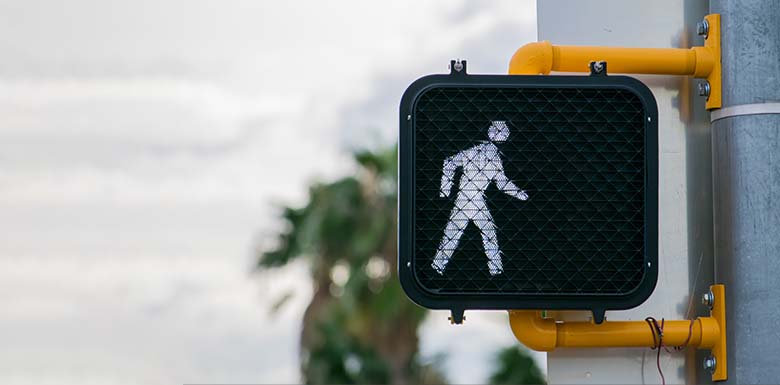
Despite laws, safety measures, and education programs, pedestrians still made up approximately 15% of total Canadian traffic fatalities in 2020. Pedestrians lucky enough to survive a collision often suffer lasting injuries and require extensive medical attention.
The urban sprawl and physical differences between cars and people are among the many factors contributing to these accidents’ frequency and severity. Knowing your rights when crossing the street is your first line of defence from negligent drivers.
The Dangers of Pedestrian vs. Vehicle Accidents in Huron County
While typical car accidents are always dangerous, drivers at least have some protection inside a vehicle. Additionally, standard airbags and seatbelts effectively mitigate the impact of a collision.
None of these are present when a pedestrian is hit by a car. With cars averaging 900 kgs, the sheer size difference leaves drivers, for the most part, unharmed and pedestrians fatally wounded.
Aside from the physical differences between cars and people, speed plays a significant role in pedestrian fatalities. It’s been reported that pedestrians have a 90% chance of survival when hit by a driver going 30 km/h and a 20% chance of survival when drivers go 64 km/h.
Pedestrian vs. Car Accident Scenarios
Over the years of Ontario’s battle with pedestrian fatalities, the Office of the Chief Coroner highlighted the common scenarios involving pedestrian fatalities:
- Individuals hit while proceeding legally through a crosswalk
- Drivers who hit pedestrians on the side of the road
- Instances where a pedestrian was hit at an intersection when the driver had the right-of-way
- Drivers making a left turn and hitting pedestrians in an intersection
- Drivers who hit passengers while making a right turn through an intersection.
Where & When Do Pedestrian Accidents Occur in Ontario?
Crowded urban areas are prime spots for pedestrian fatalities. While pedestrians have the right-of-way, drivers who speed down busy streets give people little time to cross.
Within urban environments, intersections and crosswalks are the most common accident scenes. Additionally, many pedestrian vs. car accidents have been reported in areas with high foot traffic, like school zones where drivers are required to lower their speed.
The time of day is also a significant factor— with over half occurring at night-time due to low visibility and fatigue.
Who’s At Risk for Pedestrian Accidents?
Children and the elderly are among the top victims of pedestrian accidents involving cars. Transport Canada reports that approximately 63% of pedestrians killed at intersections were 65 and older — and while 6% of fatally injured pedestrians were under 16, 20% died because they ran into the street.
For older victims, it mainly comes down to their inability to judge how long it takes them to cross the road due to their decreased mobility compared to younger pedestrians.
Children are also at risk because they lack the required road safety understanding and may run out into the street without thinking. Although both the elderly and young children are more vulnerable to oncoming vehicles, anyone can be struck by a negligent driver.
Ontario Right of Way & Crosswalks Laws
As stated, pedestrians have the right-of-way in most cases. Therefore, drivers must abide by the following laws when pedestrians are using crosswalks:
- They must stop before entering the crosswalk
- They can’t pass another vehicle stopped at a crosswalk
- They can’t proceed through the crosswalk until the pedestrian has fully made it across
Vehicles are also not allowed to pass other cars within 30 meters of a crosswalk. The bottom line is that when pedestrians are legally crossing a roadway — whether it be a crosswalk or intersection — they have the right-of-way.
What Is the Duty of the Pedestrian?
Although oncoming cars must take caution when approaching intersections or crosswalks, specific laws might also hold pedestrians partially accountable for a collision. For example, pedestrians can’t run or walk out in front of a vehicle at a point where the car has an unreasonable amount of time to react.
The law also requires pedestrians to remain within the marked section of the crosswalk as they proceed through the road. Further, intoxicated or otherwise impaired pedestrians might be partially liable for accidents or injuries sustained during a crash.
Preventing Pedestrian Accidents in Huron County
Various technologies and vehicle modifications like automatic braking systems, hazard warnings, and even external airbags that consider pedestrian safety have reduced fatalities. However, with the continued rise in pedestrian accidents in Ontario and throughout Canada, areas have initiated plans to educate both drivers and pedestrians on the rules of the road to keep everyone safe.
Since speed is also a significant factor in pedestrian fatalities, speed limits have been assessed and lowered in high-traffic areas.
Were You Hit by a Car in Ontario?
Injured pedestrians should know their rights and options to hold reckless drivers accountable. Whatever the details of the case may be, if you or a loved one were struck by a motor vehicle in Southwestern Ontario, Donnelly Murphy car accident lawyers can advise you and help recover financial compensation for your related losses.
Call (519) 524-2154 to schedule your no-cost, risk-free consultation.